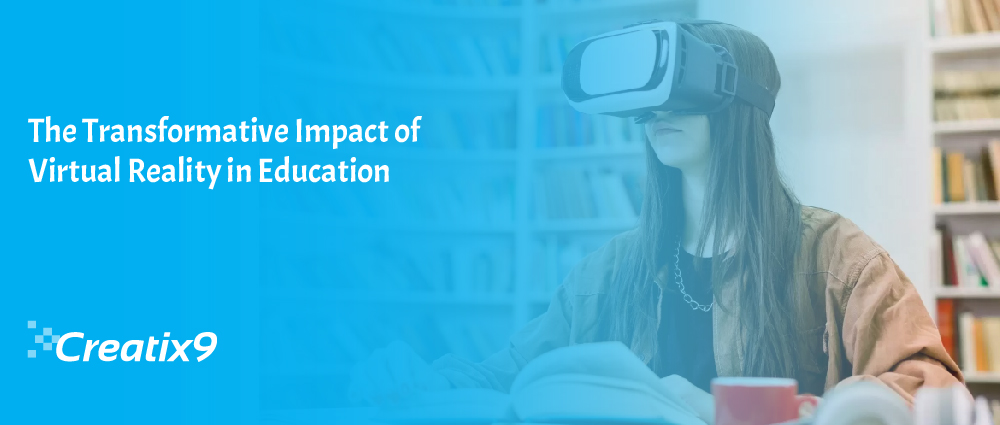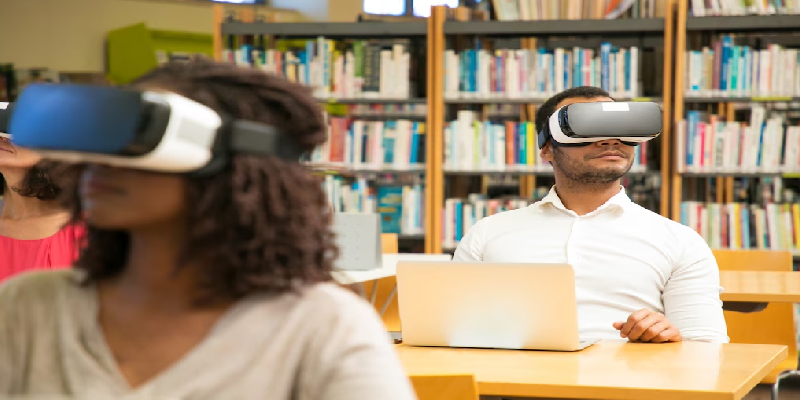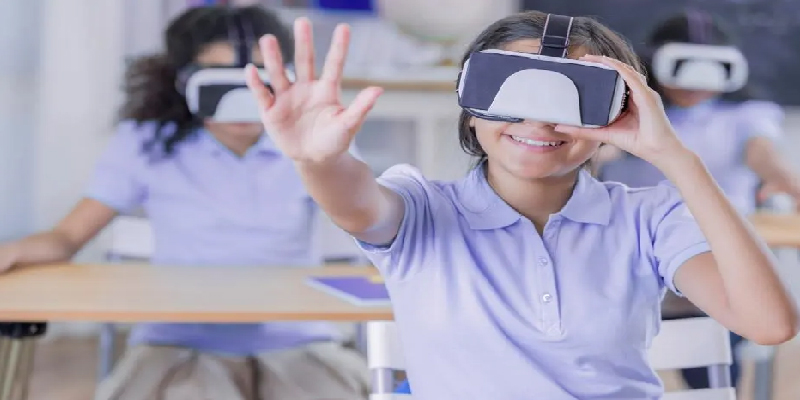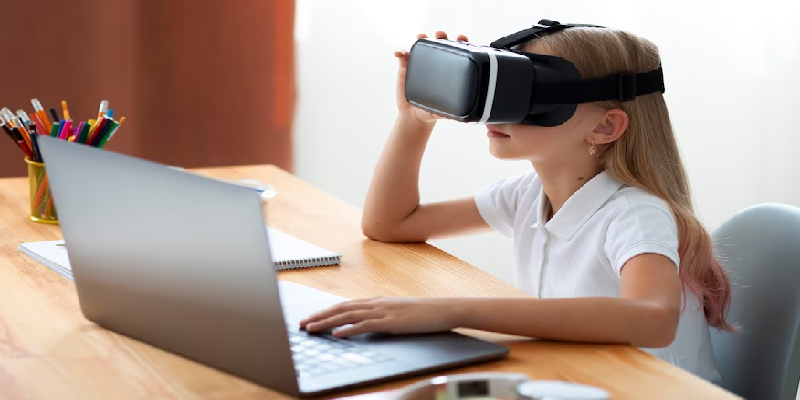
Education has not been exempt from the technological transformation that has occurred recently in many other businesses. Virtual Reality (VR) stands out as a game-changer among the ground-breaking inventions, revolutionising how students study, and teachers impart knowledge. This blog will look into the field of virtual reality in education and its plethora of advantages. According to Statista, The market for virtual reality was expected to grow from less than 12 billion dollars in 2022 to more than 22 billion dollars by 2025, indicating that the business is expanding quickly.
VR is altering the educational landscape and paving the way for a more interesting and effective learning journey, from improving classroom experiences to enabling immersive learning settings with the help of a professional digital agency.
Understanding Virtual Reality in Education

Virtual reality, which frequently combines auditory, visual, and haptic feedback, is an interactive computer-generated experience that immerses participants in a simulated environment. Virtual reality (VR) technology gives students the chance to explore complicated ideas and real-world situations that are otherwise difficult or impossible to experience in a typical classroom setting. Students can fully immerse themselves in virtual worlds by donning VR headsets, opening the door to immersive learning like never before. A good VR and video animation company can help students to know more about what they are learning.
Immersive Learning Environments

The capacity to build immersive learning environments is among VR’s most important educational benefits. Students can virtually visit historical sites, dive to the bottom of the ocean, fly to outer space, or even communicate with prehistoric civilizations by using VR simulations. These experiences foster active engagement and curiosity, making learning enjoyable and memorable.
Enhanced Retention and Comprehension

Numerous studies have demonstrated that experiential learning delivered via VR can enhance recall and comprehension. Students are more likely to retain information and comprehend difficult topics when they actively participate in educational experiences. VR facilitates multi-sensory learning, appealing to various learning styles through whiteboard animation in the UK and ensuring that students grasp the material more effectively.
Personalised Learning Paths

In a traditional classroom, it can be challenging for educators to cater to the diverse needs of individual students. However, VR in education allows for personalised learning paths. With adaptive VR learning platforms, students can progress at their own pace, receiving customised content based on their strengths and weaknesses. This personalised approach enhances student confidence and encourages self-directed learning.
Breaking Geographical Barriers
VR has the potential to break geographical barriers and provide equal educational opportunities to students worldwide. There may not be as much access to high-quality education in rural or underprivileged locations. Through the use of virtual reality (VR) technology, students can access a multitude of instructional materials, 2d animation services, and experiences that transcend physical limitations and provide an egalitarian learning environment for all.
Empowering STEM Education
VR has demonstrated to have a significant influence when used in STEM (Science, Technology, Engineering, and Mathematics) education. Students can conduct virtual experiments, visualise difficult scientific ideas, and get practical experience in a risk-free setting using VR simulations. As a result, pupils are more motivated to investigate STEM fields, and the groundwork for future innovators and problem-solvers is laid.
Fostering Collaborative Learning
VR can also facilitate collaborative learning experiences. Students from all over the world can collaborate on projects, work through issues, and share ideas in virtual classrooms. This international cooperation promotes intercultural awareness and equips students for a globally connected world.
Overcoming Challenges and Limitations
While Virtual Reality holds immense promise in education, there are challenges to overcome. Cost considerations, the need for specialised training for educators, and potential technical glitches are some of the hurdles that institutions must navigate. However, as VR technology continues to advance, these limitations are gradually being addressed, making VR more accessible to educational institutions of all sizes.
Virtual Reality (VR) Applications in Various Industries
Virtual reality (VR) has a disruptive influence that goes beyond education and has implications in many different industries, revolutionising how firms run and engage with their stakeholders. Let’s look at some of the major sectors where virtual reality is having a big impact:
-
Healthcare:
VR is shown its potential to revolutionise patient care and medical education in the healthcare sector. Before performing actual surgeries, medical professionals and students can hone their skills using VR simulations to rehearse surgical procedures in a risk-free setting. Additionally, VR can assist in pain management and therapy by creating immersive and calming experiences for patients, reducing anxiety and discomfort during treatment.
-
Architecture and Real Estate:
VR has revolutionised the way architects and real estate developers showcase their designs and properties. Customers may visually experience buildings and interiors via VR walkthroughs, giving them a genuine feeling of space and design. This interactive interface improves client-architect communication, resulting in more informed choices and higher levels of client satisfaction.
-
Entertainment and Gaming:
One of the first industries to use VR technology was the entertainment and gaming sector. Players may enter virtual worlds and interact with their favourite games in a way that has never been possible before thanks to virtual reality (VR) technology. This technology has the ability to revolutionise the game market by offering previously unheard-of levels of interest and fun.
-
Tourism and Hospitality:
VR is reshaping the way people plan their holidays and experiences in the tourism and hospitality industry. Virtual tours enable potential travellers to explore destinations, hotels, and attractions before making bookings. By immersing potential customers in the travel experience, VR enhances the decision-making process and helps businesses stand out in a competitive market.
-
Automotive:
Through the transformation of car design, manufacturing, and sales processes, virtual reality is fostering innovation in the automotive sector. Without the need for physical prototypes, designers and engineers can utilise virtual reality to envision and test new car models, saving time and resources. Additionally, VR showrooms enable customers to virtually test-drive vehicles and customise features, streamlining the sales process.
-
Aerospace and Aviation:
In the aerospace and aviation industries, VR is utilised for pilot training and aircraft maintenance. Flight simulators equipped with VR technology allow pilots to experience various flying scenarios and emergency situations, improving their skills and response capabilities. Furthermore, VR aids maintenance technicians in conducting virtual inspections and repairs, ensuring the safety and efficiency of aircraft operations.
-
Retail and E-commerce:
The retail experience is changing thanks to virtual reality, both offline and online. By providing virtual product experiences and demonstrations in physical stores, virtual reality (VR) improves customer engagement. Customers can explore and interact with products in virtual storefronts driven by VR in e-commerce, simulating the experience of buying in a physical store.
-
Military and Defence:
The military and defence sectors leverage VR for training purposes, preparing soldiers for combat situations and mission simulations. Virtual training environments help improve decision-making, teamwork, and adaptability in challenging and high-risk scenarios. Additionally, VR is used for equipment maintenance and planning complex military operations.
-
Sports:
Sports organisations use virtual reality (VR) to improve player performance and physical training. Athletes can evaluate their motions and technique in virtual simulations to identify areas for improvement and hone their training regimens. Sports fans can have a more immersive viewing experience using VR that gives them the impression that they are on the pitch or court.
-
Marketing and Advertising:
VR has opened up new possibilities for marketing and advertising campaigns. Brands can create interactive and memorable VR experiences that engage consumers on a deeper level. VR-powered marketing campaigns can generate buzz and create lasting impressions, helping companies stand out in a crowded marketplace.
Another industry where Virtual Reality (VR) is making a significant impact is: Training and Simulation:
From the military and aviation to business and emergency services, virtual reality is revolutionising training and simulation. Employees can learn difficult activities and procedures in a controlled virtual environment with VR-based training, which offers a safe and affordable alternative to conventional hands-on training.
-
Industrial Training:
In industrial settings, VR simulations allow workers to practice operating heavy machinery and equipment without the risk of accidents or damage. This type of training enhances safety and efficiency, reducing the likelihood of workplace incidents and improving overall productivity.
-
Emergency Services:
For emergency service personnel, such as firefighters and paramedics, VR training offers realistic scenarios to prepare them for challenging situations. Firefighters can simulate firefighting operations in burning buildings, while paramedics can practice life-saving techniques in virtual emergency situations.
-
Hazardous Environments:
In environments with potential hazards, such as nuclear power plants or oil rigs, VR allows workers to familiarise themselves with safety protocols and emergency procedures. By simulating dangerous situations, workers can develop critical decision-making skills in a risk-free environment.
-
Soft Skills Training:
VR is also valuable for teaching soft skills, such as communication, conflict resolution, and leadership. Employees can participate in simulated scenarios involving customer interactions or team collaborations, enabling them to develop their interpersonal skills and build confidence.
-
Medical Training:
In addition to the healthcare sector, VR finds applications in medical training for surgeons, nurses, and other medical professionals. Surgeons can rehearse complex procedures in a virtual operating room, refining their techniques before performing surgeries on real patients.
Virtual Reality has emerged as a transformative technology with applications across various industries. From revolutionising education and training to enhancing customer experiences and driving innovation, VR is reshaping the way businesses operate and engage with their audiences. Adopting VR can provide businesses with a competitive edge, encourage innovation and creativity, and ultimately improve customer happiness and corporate success. Virtual reality is poised to play an increasingly important role in determining the future of industries across the board as we go towards a more immersive and connected world.
Conclusion
Virtual reality stands out as a revolutionary force that has the ability to alter how students learn, and teachers educate as technology continues to change the face of education. VR is changing education as we know it thanks to its immersive learning settings, improved retention, individualised learning routes, and ability to transcend geographical boundaries. It is crucial for educational institutions to embrace this innovation and take use of its potential to provide students with a more engaging, efficient, and inclusive learning experience as VR technology spreads and becomes more reasonably priced. Furthermore, if you are looking for VR services or 3d animation company then get in touch with Creatix9.

